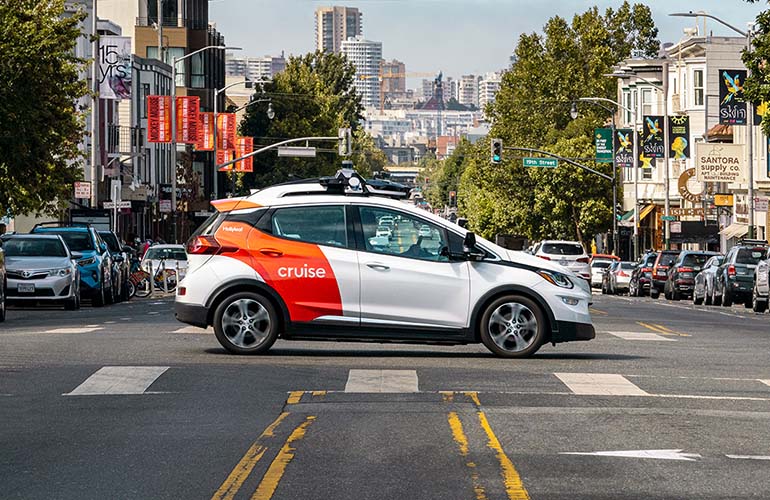|
Listen to this article  |

A Cruise autonomous vehicle operating in San Francisco. | Credit: Cruise
Over the past several weeks, autonomous driving company Cruise has shared videos of its employees taking rides in driverless robotaxis around San Francisco. Even Mary Barra, CEO and chair of GM, which owns Cruise, took a ride. Now that service appears to be opening to the public.
Cruise announced today it is “opening up” its driverless cars in San Francisco to the public. There is a sign-up form on Cruise’s website for members of the public who want to take a ride. Kyle Vogt, interim CEO, CTO, and co-founder, wrote that the service will open up to a small number of users and ramp up over time.
“We’re being cautious and careful with this rollout,” Vogt wrote. “This has never been done before in a major U.S. city, so we’ll expand the service area, hours, etc. as we learn what works and what doesn’t.”
For now, rides in the Cruise Rider Community program will be free. Members of the public who join the waitlist won’t have to sign a non-disclosure agreement before using the service. The company also says on its website that it’ll “be in more cities soon.”
1) I’m proud to announce that @Cruise is ready to welcome members of the public into our fully driverless vehicles.
Our first few riders certainly had a good time, and we hope you do too. pic.twitter.com/fseSSvqzKJ
— Kyle Vogt (@kvogt) February 1, 2022
Cruise has the three permits required by the California Department of Motor Vehicles to test, deploy and carry passengers in driverless vehicles. It also applied for a permit with the California Public Utilities Commision to charge for rides, but it doesn’t appear to have received that permit yet.
Cruise is allowed to operate five of its robotaxis around certain parts of San Francisco. Cruise vehicles are approved to operate between 10 PM and 6 AM at a maximum speed of 30 MPH. The DMV is allowing Cruise to drive its robotaxis in light rain and fog. Cruise has been able to test autonomous vehicles on California’s public roads with a safety driver since 2015 and to test autonomous vehicles without a driver since October 2020.
Cruise also published this video, which it said shows the first group of public riders.
Major milestone for robotaxis
While Cruise’s robotaxi service is only open to a small number of people in a small section of San Francisco, this is a major development for the robotaxi industry. This appears to be the first driverless robotaxi service that’s up and running, in some capacity, in a major U.S. city with a complex driving environment.
Vogt has often discussed the difficulties of driving in San Francisco. Testing in the hardest places first, he said, meant Cruise will be able to scale faster than starting with easier places. That is, of course, a reference to Waymo, which launched the world’s first driverless robotaxi service in late 2020. The service covers a 50-square-mile radius of the Phoenix suburbs. Driving autonomously around the Phoenix suburbs is no easy task, but the environment isn’t as hectic as San Francisco.
Cruise and Waymo have been competing head-to-head for years now, but Cruise legitimizes itself even further with this public launch. Waymo has also been approved to offer robotaxi rides to public passengers in California. Its permit allows it to operate its autonomous vehicles in certain parts of San Francisco and San Mateo counties. However, the vehicles must have human safety drivers behind the wheel. Waymo’s vehicles are approved to operate on public roads with a speed limit of no more than 65 MPH and can also operate in rain and light fog. The DMV didn’t specify a timeframe in which Waymo’s vehicles could operate.
A number of Chinese autonomous driving companies made significant progress in 2021. And just last week, Alibaba-backed AutoX, expanded its driverless robotaxi range to 386 square miles in Shenzhen, China. AutoX has offered a fully driverless robotaxi service to the public since January 2021. After one year of operation, the service area in Shenzhen has gradually expanded to become the largest fully driverless RoboTaxi zone in China.
AutoX claimed the video above shows one of its driverless robotaxis navigating the expanded service area for a total of almost six hours without any disengagement.
Raising $1.35 billion from Softbank
Cruise also announced it raised another $1.35 billion through the Softbank Vision Fund. This increases the company’s total funding raised to nearly $15 billion. In 2018, SoftBank Vision Fund invested $900 million in the GM-backed Cruise.
In a blog, Vogt wrote that the new capital will “help us expand our world-class team and quickly scale this technology across SF and into more communities.”
Credit: Source link


Comments are closed.